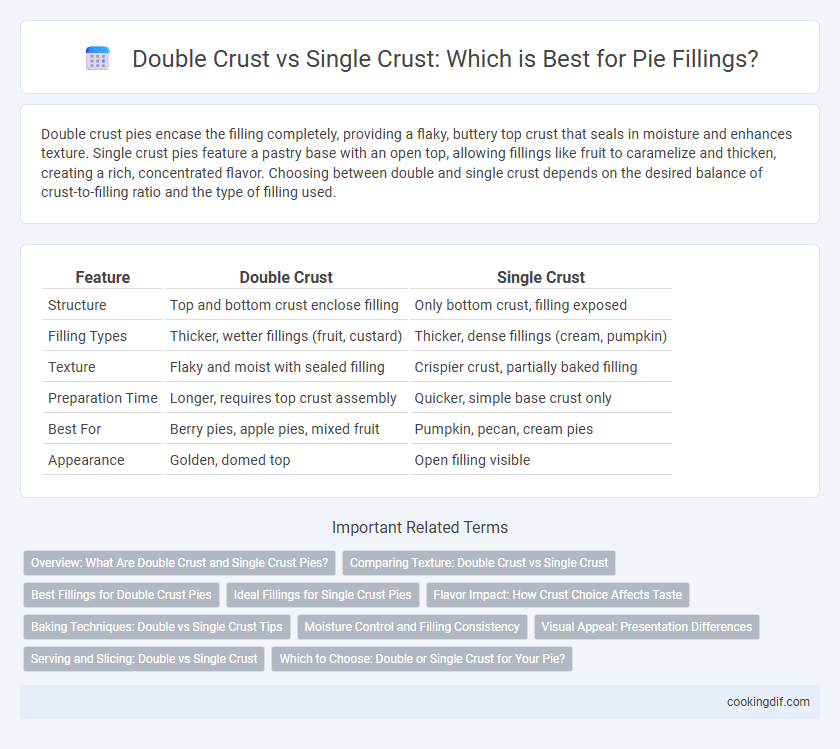Double crust pies encase the filling completely, providing a flaky, buttery top crust that seals in moisture and enhances texture. Single crust pies feature a pastry base with an open top, allowing fillings like fruit to caramelize and thicken, creating a rich, concentrated flavor. Choosing between double and single crust depends on the desired balance of crust-to-filling ratio and the type of filling used.
Table of Comparison
| Feature | Double Crust | Single Crust |
|---|---|---|
| Structure | Top and bottom crust enclose filling | Only bottom crust, filling exposed |
| Filling Types | Thicker, wetter fillings (fruit, custard) | Thicker, dense fillings (cream, pumpkin) |
| Texture | Flaky and moist with sealed filling | Crispier crust, partially baked filling |
| Preparation Time | Longer, requires top crust assembly | Quicker, simple base crust only |
| Best For | Berry pies, apple pies, mixed fruit | Pumpkin, pecan, cream pies |
| Appearance | Golden, domed top | Open filling visible |
Overview: What Are Double Crust and Single Crust Pies?
Double crust pies feature both a bottom and top layer of pastry, enclosing the filling completely, which helps retain moisture and flavors during baking. Single crust pies consist of only a bottom crust with an open top, often topped with meringue or fruit, allowing the filling to be more visible and sometimes resulting in a lighter texture. The choice between double and single crust affects the pie's texture, appearance, and how the filling cooks and interacts with the crust.
Comparing Texture: Double Crust vs Single Crust
Double crust pies offer a contrasting texture with a flaky, crisp top layer encasing the filling, providing a more structured bite. Single crust pies tend to have a tender, buttery base that highlights the filling's moisture without the added crunch on top. The dual layers in double crust pies create a balance between soft filling and crispy pastry, while single crust pies emphasize a softer, more delicate overall texture.
Best Fillings for Double Crust Pies
Double crust pies excel with hearty fillings like apple, cherry, and blueberry, as the top crust traps moisture and flavors, creating a rich, juicy texture. Dense fruit mixtures with natural juices benefit from the protective two-layer crust that prevents sogginess and enhances baking consistency. Creamy or custard fillings typically suit single crust pies better, while double crust configurations maximize the potential of spiced, chunky fruit blends.
Ideal Fillings for Single Crust Pies
Single crust pies are ideal for custard, chiffon, and cream fillings that don't require a top crust for protection or sealing. Delicate fruits like berries or pumpkin work well in single crust pies because their juices won't soak through a bottom-only crust. This type allows the filling's texture and flavor to shine without the added weight or moisture from a double crust.
Flavor Impact: How Crust Choice Affects Taste
Double crust pies encase the filling completely, creating a harmonious blend where the buttery, flaky crust complements and seals in the rich flavors, enhancing overall taste intensity. Single crust pies, often with exposed fillings, allow the fruit or savory ingredients to shine with more pronounced natural flavors while providing a crisp contrast to the softer interior. The choice between double and single crust significantly influences flavor balance, moisture retention, and texture, shaping the pie's final taste experience.
Baking Techniques: Double vs Single Crust Tips
Double crust pies provide a sealed environment that traps moisture, resulting in juicier fillings and a more tender bottom crust, ideal for fruit pies with liquid fillings. Single crust pies require blind baking or careful layering to prevent sogginess, especially for custard or cream fillings where a firm, crisp base is essential. Using chilled dough and venting the top crust in double crust pies ensures even baking and prevents overflow, while brushing with egg wash enhances browning and texture for both crust types.
Moisture Control and Filling Consistency
Double crust pies provide better moisture control by sealing in juices, preventing soggy bottoms and ensuring a firm filling consistency. Single crust pies may allow more steam to escape, which can lead to a drier filling or inconsistent texture. Proper crust choice is essential for maintaining the ideal balance of moisture and consistency in fruit or custard fillings.
Visual Appeal: Presentation Differences
Double crust pies offer a classic, symmetrical appearance with a fully enclosed filling, creating a golden, textured top that adds depth and visual interest. Single crust pies showcase the vibrant colors and textures of the filling directly, often topped with lattice or decorative edges to enhance the presentation. The choice between double and single crust significantly impacts the pie's aesthetic appeal, with double crust emphasizing form and texture, while single crust highlights the filling's natural beauty.
Serving and Slicing: Double vs Single Crust
Double crust pies provide a sturdy structure that facilitates clean, uniform slices, making serving easier and more visually appealing. Single crust pies, often with an open top, may result in softer edges and less defined slices, which can require more careful handling when serving. The enclosed nature of double crust pies helps retain fillings better, preventing spills during slicing and serving.
Which to Choose: Double or Single Crust for Your Pie?
Choosing between double crust and single crust depends on the type of filling and desired texture; double crust pies are ideal for fruit fillings like apple or cherry, offering a sealed, juicy center and a crisp top crust. Single crust pies suit cream or custard fillings such as pumpkin or pecan, providing a flaky base that supports delicate, rich textures without additional topping. Consider the filling consistency and baking time to ensure balanced moisture and optimal crust doneness.
Double crust vs single crust for fillings Infographic

 cookingdif.com
cookingdif.com